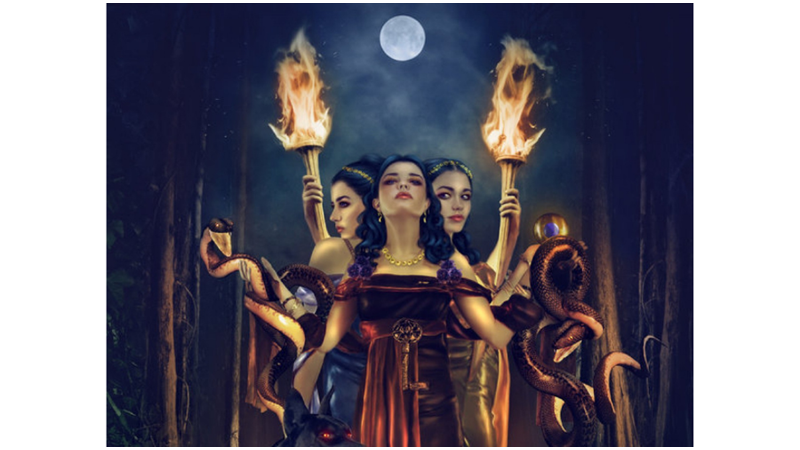Yunan Mitolojisinde ay ve gece ile ilişkilendirilen Hekate, bakire bir tanrıçadır. Titan soylu Perses ve Asteria'nın kızıdır. Aynı zamanda ölüler, yeraltı ve büyücülük ile ilişkilendirilir. Bu yüzden tanrıçaya korkuyla karışık saygı duyulur.
Mitolojide çok ön planda olmayan Hekate'ye, özellikle erken Hristiyanlık döneminde birçok olumsuz anlam yüklenmiştir. Günümüzde Neopaganizmde sevilen bir tanrıçadır. Türkiye'de Lagina Antik Kenti ve Trakya açıklarındaki Semadirek adası, tanrıçanın en önemli kült merkezleridir.
Özellikle Karyalılar tarafından sevilen tanrıça Hekate, Anadolu veya Trakya kökenlidir. Tanrıça, Artemis ve Apollo ile anne tarafından kuzendir. Tanrıların tanrısı Zeus dünyayı, kendisi gökyüzünü, kardeşi Poseidon denizleri, bir diğer kardeşi Hades ise yeraltını alacak şekilde paylaştırır. Tanrıça Hekate bu üç alanda da yetki sahibidir. Üç yüzlü tasviri zamanla ay tanrıçaları Hekate-Artemis-Selene şeklinde bir üçleme oluşturur.
Associated with the moon and night in Greek Mythology, Hecate is a virgin goddess. She is the daughter of the titanic nobles Perses and Asteria. She is also associated with the dead, the underworld, and witchcraft she. That's why the goddess is revered mixed with fear.
Hecate, who is not very prominent in mythology, was attributed many negative meanings, especially in the early Christian period. She is a beloved goddess in Neopaganism today. Lagina Ancient City in Turkey and Samothrace Island off Thrace are the most important cult centers of the goddess.
The goddess Hecate, especially loved by the Carians, is of Anatolian or Thrace origin. The goddess is maternal cousin to Artemis and Apollo. Zeus, the god of gods, divides the world so that he receives the sky, his brother Poseidon the seas, and another brother Hades the underground. Goddess Hecate has authority in all three areas. The three-faced depiction eventually forms a trilogy in the form of the moon goddesses Hecate-Artemis-Selene.


 Nielawore
Nielawore










Yorum yazmak için lütfen giriş yapınız